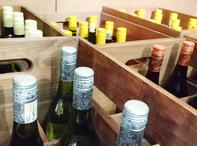Leftover Wine
If in the aftermath of a celebration, whether it was raising a glass to the end of the week or participating in standard festivities like a birthday or an anniversary, leftover wine is a result, perhaps a question worth asking is: was there even a celebration? Once an adequate answer appears a follow-up question worth asking its: how to store open wine?

Storing an open bottle of wine with the hopes of its contents still being palatable and not akin to pricey vinegar is essentially a race against time. So after each pour be sure to re-cork or screw the cap back on, as this is the most convenient method to reduce the amount of oxygen entering the wine bottle. Keep the bottle out of light or better yet, place it in a refrigerator.
Lower temperatures help to slow down the oxidation process. An open bottle of red wine once stored in a fridge can maintain a degree of freshness anywhere from 3 to 5 days. Though pushing the 5 day mark is asking for an acidic experience rather than a full bouquet of aromatic joy.
Points to Note
When storing an open bottle of wine, store it in an upright position instead of laying it on its side, as the latter position increases the wine’s exposure to oxygen. Try to avoid any fluctuation in temperature as this also comprises the composition of the wine. It is always preferable to store an open bottle of wine in a cool place away from sunlight, e.g. a fridge.
Storing Wine

Storing wine and surveying one’s accumulation of liquid happiness is possibly one of the most rewarding pastimes to partake in. Second only to actually drinking said collection. In search of a quick guide to achieving a drinkable domestic aesthetic that does not spoil, one that simultaneously purrs sophistication? Well then, read on.
Wine, hard to imagine yet very true, is a deliciously fragile elixir that when handled incorrectly can merit a lot of oral disappointment. How does one avoid the taste of sadness? One follows these tips:
Right Temperature
Achieving the right temperature to keep wine in a wonderful palatable state is the most important step in storing wine. Taking a note out of the Goldilocks playbook, not too cold and not too hot is the sweet spot that wine deserves. In Fahrenheit, this is 50 to 58 degrees, and in Celsius it is 10 to 14.4 degrees. In short, no direct sunlight or anywhere that is overly lit or prone to fluctuating temperatures, like kitchens, near a fireplace or indoor braai (barbecue) area. The inconsistent heat will wreak havoc on your wine. Maintaining an ideal temperature is the most considerate application to create for your collection of wine.
Bottle Position
Whether wine is stored in a dedicated wine fridge or in an area that is dimly lit and not affected by oscillating temperatures, the bottle position is also of importance. For instance, corked wine should be stored on its side. This will allow the cork to remain moist, thus reducing the amount of air that enters the bottle. A dry cork will permit more air to seep through, which increases the likelihood of oxidation taking place. And heavily oxidized wine does not make for enjoyable wine. Screwcap wine does not have to adhere to the same storage requirement and can be kept upright or sideways.
Friendly Environment
Just as maintaining the right temperature is an important factor in ensuring wine remains drinkable, so too is ensuring that the environment in which wine is stored is humid. A humid environment allows corked wine to sidestep the oxidation process from prematurely happening. After all, a moist cork is a happy cork.
Adding a humidifier to the room in which wine is stored, will assist in maintaining the ideal wine storage ecology. Additionally, keeping bottled wine stable will help to keep wine in good form. Wine that is constantly disturbed, be it through shaking, vibrations, and regular movements will age in a decidedly unfavourable manner.